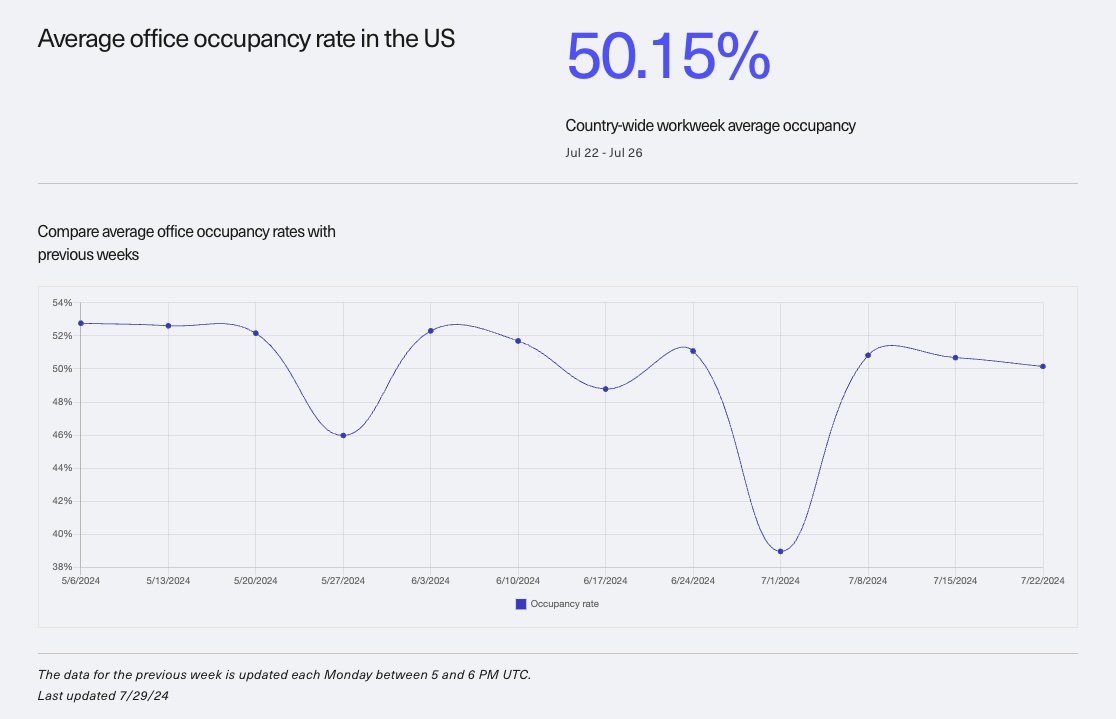Remote work has become increasingly prevalent since the COVID-19 pandemic, alongside with digital communication and collaboration tools, such as video conferencing, project management software, and cloud-based platforms. Moreover, remote work has evolved into various models, ranging from fully remote to hybrid and roaming arrangements.
As the pandemic impact decreased many companies aimed to create an effective return-to-office (RTO) strategy. Choosing work models aligned with the company's mission, ensuring security and compliance, balancing employee preferences, addressing productivity and engagement, investing in technology, and navigating long-term uncertainty are some of the challenges companies are facing.
As a solution, workplace data emerges with the potential to shape effective RTO strategies. With workplace data, organizations can learn valuable insights into employee preferences, productivity patterns, and space utilization. Companies can also leverage the data to create a more flexible, efficient, and supportive work environment tailored to their workforce's needs.
In this article, we will dive deeper into insights, statistics, and expert opinions on remote work and workplace data.
What is remote work? #
Remote work is a work model that allows employees to work outside of a typical office environment, often from home, or other locations organized individually, such as coworking and shared spaces.
While remote workers mostly work from outside an office space, they still might come to a physical space and join on-site meet-ups when needed. This approach differs slightly from hybrid work models, where employees are typically expected to work remotely part of the week but must attend the office on specific days regularly.
As for work schedule, remote work tends to offer various degrees of flexibility, depending on individual company policies. Some organizations adopt a fully flexible approach, allowing employees to set their own hours as long as they meet deadlines and complete tasks, while other companies might require more fixed terms. For hybrid workers, specific work hours often apply whether they are working remotely or in the office.
Explore Kisi's Future of Workplace Guide to find detailed information about emerging work models and the main differences between on-site, hybrid, and remote work models.
What is workplace data? #
Workplace data refers to the collection and analysis of information related to the physical and digital environments where employees work. This data includes metrics on space utilization, in-person interactions, and employee productivity. It can also encompass aspects such as:
- Office occupancy rates
- Desk occupancy rates
- Meeting rooms usage
- Security data
By leveraging workplace data, organizations can optimize their office layouts, enhance employee satisfaction, improve operational efficiency, and support decision-making related to remote and hybrid work models.
The state of remote work #
Remote work is a spectrum, ranging from 100% work from home (WFH) arrangements to part-time remote work, as happens with hybrid models. In any case, it is clear that remote work is here to stay. Let's look at some reflections and statistics.
Statistics and trends in remote work #
Understanding statics and trends in remote work helps us see how it affects workers and company strategies. Some recent trends include:
- Growth in remote work: The percentage of employees working remotely has surged. In fact, a McKinsey survey from 2024 found that 58% of employed respondents, equivalent to about 92 million people in the U.S., have the option to work from home for all or part of the week.
- Reshaping workplace: The reimagining of office spaces into more attractive, multi-functional environments is becoming essential to meet the new demands of the workforce and to maintain property values. According to McKinsey's 2023 real estate report, the trend towards hybrid work has led to a substantial increase in vacant office spaces in the US - some cities experience up to 70% vacancy rates.
- Digital transformation and collaboration: Companies are investing in digital collaboration tools and cybersecurity while redefining physical offices to focus more on collaboration spaces rather than individual workstations. Microsoft’s 2022 Work Trend Index shows that 73% of employees want flexible remote work options to continue; at the same time, 67% of them want more in-person interaction with their teams.

Benefits and challenges of remote work #
Remote work offers significant benefits to employees and employers alike, including increased flexibility, enhanced work-life balance, and access to a wider talent pool. However, it also presents challenges that need to be considered when planning a RTO strategy.
Benefits of remote work:
- Flexibility: With a flexible schedule, employees can better balance work and personal life, which might lead to better employee satisfaction.
- Cost savings: Remote work models allow both employers and employees to save on costs related to commuting, office space, and daily expenses.
- Global talent: Employers can hire talent from anywhere in the world, expanding their potential candidate pool. Additionally, data from Forbes highlights that companies adopting remote work can leverage online talent platforms, further facilitating global hiring.
Challenges of remote work:
- Communication: Remote work can lead to misunderstandings and a lack of effective communication without in-person interactions.
- Mental health: Employees may experience a lack of social connection, which can impact their mental well-being and productivity. In fact, a study by Buffer in their 2023 State of Remote Work report found that 25% of remote workers reported feeling lonely or isolated.
- Management: Supervising remote employees can be challenging, requiring new management approaches and tools to ensure accountability and performance.
Proprietary office occupancy data #
Identifying effective KPIs for a RTO strategy can be challenging without some benchmark data.
Proprietary office occupancy data involves using sensors and IoT devices, like access control, to track the real-time usage of office spaces, helping organizations understand patterns of employee presence and absence, as well as ebbs and flows due to visitors and guests.
Analyzing occupancy data helps organizations make informed decisions regarding office layouts, capacity planning, and future real estate investments.

Kisi’s Office Occupancy Index #
Physical security systems like Kisi provide companies with office occupancy data, which enables companies to make informed decisions about their work models and optimize workplace utilization and employee experience.
Why Kisi is relevant for measuring office occupancy #
Through its Return to Office Trends: Occupancy Data Index, Kisi offers a forecast based on physical security and access control data. The office occupancy rate is calculated by dividing the number of all daily unique door unlocks by the maximum office capacity number.
By tracking this data, a number of dimensions can be measured and analyzed, including office occupancy per industry, company size, weekday, time in the day, and more. This can help companies gain insight into office usage. Let's take a look at a few examples below.
Key insights and findings from the Kisi's Return to Office Index: #
From August 2023 to August 2024, considering several US industries:
- The average office occupancy rate is 50%. This country-wide trend shows that companies tend to adopt a hybrid work model.
- Mondays, Tuesdays, Wednesdays are the most popular weekdays to work from the office. With this data, companies can improve office usage and, for example, plan RTO strategies and on-site events considering the weekdays of higher office attendance.
- Companies with 1-49 employees lead the trend of returning to the office, while companies with 1000-24999 employees incorporate more remote work. This indicates that smaller companies might need to optimize the office space for better employee experience, while bigger companies might need to focus on repurposing unused office space or creating more engaging spaces.

Is remote work going away? #
Industry trends #
The way companies integrate the physical and the digital spaces will be key to enhancing employee experiences, especially in an era of hybrid work. A few related trends are:
- Hybrid workplace security: With increased office flexibility comes a more dynamic approach to access management, and therefore to physical security. A Cisco survey found that 86% of IT leaders consider securing hybrid work spaces a top priority.
- Digital buildings: According to a report by JLL, 70% of companies are investing in smart building technologies to enhance workplace experiences and enhance operations in hybrid environments. Examples are access control systems and real-time occupancy data analytics.
- Data-driven decisions: Data is essential to informing resource allocation to real estate and RTO strategies. A Deloitte survey revealed that 65% of organizations are using data analytics to optimize workplace usage and employee engagement in hybrid models.
Expert opinions #
Here are a few of Kisi's customers and partners assessment on the state of remote work, during Kisi Connect 2024:
Remote work is here to stay
"In the past two years, working from home really stabilized. We have an average of 30% of the work week being done remotely." - Liza Mash Levin, Co-founder and CEO of Gable.
Reimagining workplaces is key
Michael Przytula, MD Intelligent & Digital Workplaces at Accenture says: "It's not just about having an amazing building in an amazing location with a great view. It's all about the experiences that we build in there."
Factors influencing the future of remote work #
Since the shift to remote work, ideas like smart buildings, flexible offices, and integrated systems gained relevance, alongside an industry shift in commercial real estate models. In particular, investments in digital transformation are needed to equip remote and hybrid work environments with infrastructure, systems, and tools that ensure compliant security measures, seamless connectivity, and efficient access management of shared and flexible offices - including coworking spaces.
How are companies adapting to remote and hybrid models? #
Companies are investing in technology that can help support hybrid workplaces by reducing costs, streamlining operations, and enhancing hybrid workplace security and employee experience. Kisi is one of these sought after technologies.
Kisi allows companies to remotely manage access to all locations, track occupancy data, and get automated reports. Both employees and office managers can enjoy a unified access experience through all entry points with a modern access control for the hybrid workplace, including:
- On-demand global access badge
- Automated access management
- Occupancy tracking and reporting

The role of workplace data in shaping the future #
Importance of data-driven decision making #
Data helps organizations to design their strategies on empirical evidence rather than from opinions or guesswork. By leveraging accurate data analytics, companies can take informed decisions, optimize operations, enhance experiences, and mitigate risks. This improves efficiency and effectiveness in business, ultimately leading to better results and competitive advantage.
How companies use workplace data to optimize office space and productivity #
By leveraging tools like IoT sensors and occupancy analytics, organizations can identify spaces that are not utilized and adjust layouts to create more collaborative environments. This data-driven approach enables businesses to implement flexible work arrangements, streamline resource allocation, and foster a more engaging workplace, ultimately improving employee satisfaction and overall operational efficiency.
Examples of data-driven workplace strategies #
Doctors of BC, a voluntary health organization utilized Kisi’s accurate reporting of occupancy data to optimize their spaces and streamline operations. Even though Doctors of BC have a desk booking system in place, they couldn’t completely enforce its use, meaning tracking the used space was challenging.
With Kisi, Doctors of BC users gain access to the building and unlock specific doors. Moreover, admins get reports on the exact number of visitors and can filter data by user groups. This data helps office managers understand which floor or space is being used most to make informed real estate decisions moving forward.
"I was already in the process of trying to get occupancy data aggregated from different sources, and then Kisi came along, and I realized it’s all already there."- Brandon Babcock, Building and Infrastructure Manager, Doctors of BC.
Future remote work predictions and trends #
Emerging trends in remote work and workplace data #
The rise of hybrid work models, increased investment in digital transformation, and the use of advanced analytics to monitor employee productivity and space utilization are some of the emerging trends in remote work and workplace data. These trends reflect a shift towards flexible work models, data-driven approaches to managing work environments, and a focus on employee engagement and well-being.
Predictions for the next 5-10 years #
In the near future, remote work is expected to shift towards more in-person, hybrid work, and then stabilize over time. Advanced analytics and AI will be a part of work experiences and optimize space utilization and operation. Enhanced cybersecurity and adaptive workplaces such as digital buildings will also become standard, supporting a culture of both remote and in-office work. To get employees back to offices, companies will not only need to focus on space utilization but also on providing convenient experiences and engaging spaces.
How companies can prepare for the future of work #
By fostering a culture of continuous learning and adaptability companies will be more prepared to navigate the evolving work landscape. To start, organizations may look into:
- Adopting flexible work policies - remote/hybrid work is here to stay;
- Investing in digital transformation - like collaboration tools and IoT systems;
- Focusing on experience - to attract employees out of their homes, the whole workplace experience needs to be convenient and seamless
- Enhancing security measures - from physical security to cybersecurity;
- Utilizing data analytics to optimize workplace and productivity.
Get ready for the future #
Ranging from fully remote to hybrid and roaming set ups, new work models are emerging and driving companies to focus on return to office (RTO) strategies. To get ready for the future of work, investments in workplace data analytics are essential, alongside enhanced security and digital collaboration tools.
With workplace data, organizations can take data-driven decisions regarding real estate investments and office space usage, leveraging insights to reduce costs and boost employee engagement and productivity. Proptech solutions like Kisi offer products and services that streamline hybrid workplace safety and operations, while providing accurate and detailed workplace data.
Want to improve your hybrid work set up? Enhance hybrid work security and streamline operations by enabling people to access the spaces they need when they need it with Kisi’s access control. Contact our team for a solution tailored to your needs.

Natália Santana Faria
Natália, Content Marketing Coordinator at Kisi, is dedicated to bringing the latest trends in the access control industry.



